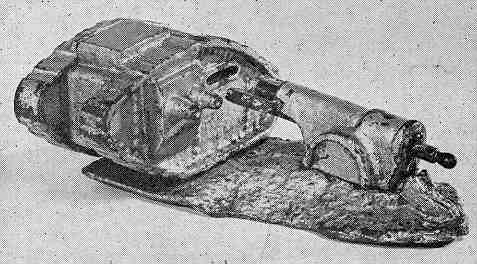Tank and Cannon Bank
by F.H. Griffith - HOBBIES Magazine - April, 1959

Historical mechanical banks are always of great interest and as we reach No. 73 in the numerical classification of the mechanical banks we have chosen a bank that well represents a period of our history. The bank is the Tank And Cannon and it represents two lethal items of World War I. This bank and possibly the Called Out Bank (HOBBIES, October, 1955) are the only known mechanical banks with a World War I theme. There are, of course, other mechanical banks that employed the theme of a specific war as their subject matter. One was the U.S. And Spain Bank (HOBBIES, June, 1954) which had its connection with the Spanish-American War, and another is the Octagonal Fort Bank (HOBBIES, August, 1954) which is a Civil War Commemorative item.
The Tank And Cannon Bank was patented May 4, 1920 by Robert Eastwood Starkie and Nellie Starkie of Burnley, Lancaster, England. Their application was filed May 12, 1919. The bank as actually manufactured closely follows the descriptive matter contained in the patent papers along with the accompanying diagram. So far the actual concern that made the bank is unknown and this may well remain so. The writer has spent considerable time on research on the Starkie’s but to little avail. While we have knowledge of various banks that the Starkie’s patented so far no information has been available as to any concern in England who actually made the banks. The Tank And Cannon Bank was unquestionably made in England and protected in this Country by the patent papers previously mentioned.
The bank shown is in good condition and was obtained through the help of Frank Ball of Cambridge, Mass. He, of course, is the well known dean of dealers in mechanical banks and toys. Mr. Ball obtained the bank through a party who had originally found it in England. The paint is in pretty fair condition and it is simply an overall silver type paint. The bank is inclined to be a little crude in its construction as compared with the standards of those made in our Country. It is quite heavy and the castings are rather thick. It’s likely that circumstances surrounding the time and place of manufacture were a factor, however, a number of the English banks seem to have been produced with less care than was used in the manufacture of the American made banks.
To operate the bank a coin is placed on the flat surface end of the barrel of the cannon after the plunger firing mechanism is pulled back. Upon releasing the plunger the coin is fired into the tank. There is no coin trap and the coins can be removed only by taking off one side of the tank which is held in place by a screw. Both the cannon and the tank are somewhat adjustable so that the firing of the coin can be more or less a matter of skill. This is accomplished by means of adjusting the respective screws that hold the tank and cannon in place on the base.
Previously it was mentioned that the Tank And Cannon and possibly the Called Out Bank were the only mechanical banks to commemorate World War I. It might be well to point out that another patent was issued on a mechanical bank that would come into the World War I category. On February 17, 1920, Chester A. Herle of Rochester, N.Y., patented a bank that represented Uncle Sam knocking out the Kaiser. This was to have a chute-like arrangement whereby the weight of the coin tripped the lever which caused Uncle Sam’s arm to punch the Kaiser in the jaw. The head of the Kaiser in turn fell back. No examples of this bank have ever been found, however, and it is doubtful that it was ever manufactured.
In summing up, the Tank And Cannon Bank is a very interesting example of a historical English bank and so far there are only two or possibly three known to have been found to date.
